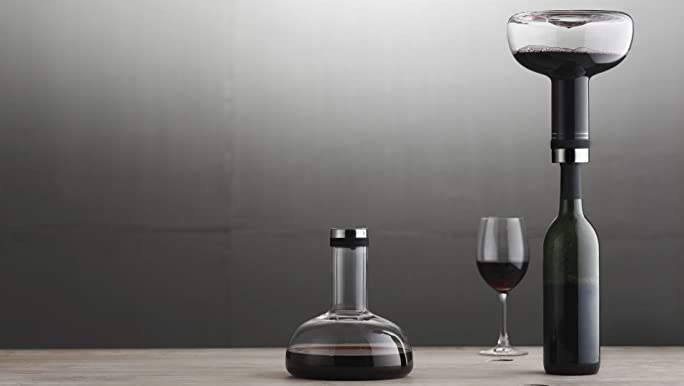We often come across the terms “decanting” and “aerating,” but what do they really mean, and how can they enhance our wine-drinking experience? Today, we dive into the world of decanting and aerating, exploring their benefits for both young and old wines. Additionally, we’ll discover how the Menu Wine Breather( Aeration) Carafe ( Decanting ) can be your trusted companion in achieving optimal wine aeration.
Decanting Young Wines: Decanting young wines, particularly those full-bodied reds, is a practice that can greatly improve their flavour profile and aromas. When a young wine is poured into a decanter, it is exposed to oxygen, allowing it to “breathe” and develop more quickly than it would in the bottle. This process not only softens harsh tannins but also enhances the wine’s fruitiness and complexity.
Benefits of Decanting Young Wines:
- Aeration: Young wines often have high levels of tannins, which can give them a firm and gripping sensation. Decanting allows the wine to interact with oxygen, softening the tannins and making the wine more approachable and enjoyable, even when it is still relatively young.
- Enhanced Aromatics: Opening up a young wine through decanting releases its aromas, allowing them to fully develop and captivate your senses. Floral notes, fruit nuances, and subtle hints of spices become more pronounced, making the wine a delight to both smell and taste.
- Sediment Removal: Many young wines can have sediment, which can be disruptive to the drinking experience. Decanting enables the separation of the sediment, ensuring a smooth and visually appealing pour.
Decanting Old Wines: Decanting isn’t only reserved for young wines; it can also breathe new life into older vintages. Over time, wines may accumulate sediment and develop complex flavours that remain hidden in the bottle. Decanting is the key to unlocking these hidden treasures and ensuring an optimal tasting experience.
Benefits of Decanting Old Wines:
- Sediment Separation: As wines age, they naturally develop sediment. By gently pouring the aged wine into a decanter, the sediment is left behind in the bottle, resulting in a clear and visually appealing pour.
- Aroma Revival: Older wines often exhibit subtle aromas that can be overshadowed by the bottle’s age. Decanting allows these delicate fragrances to flourish, offering a more aromatic and captivating experience.
- Flavour Integration: Over time, the elements of an aged wine may separate, leading to a lack of harmony. Decanting encourages the wine to meld together, smoothing out any rough edges and ensuring a more balanced and enjoyable taste.
The Menu Wine Breather Carafe is a versatile tool that can be used for both young and old wines. This innovative carafe features a unique pouring mechanism that enables easy and controlled decanting, while also facilitating efficient aeration.
The Menu Wine Breather Carafe not only simplifies the decanting process but also adds an elegant touch to your wine service. Its sleek design and functionality make it a standout choice for wine enthusiasts. Whether you’re hosting a dinner party ( you could make this is your new party trick ) or enjoying a quiet evening at home, the carafe offers a convenient and efficient way to aerate and decant your wines.
When using the Menu Wine Breather Carafe for young wines, the pouring mechanism allows for controlled aeration. As the wine flows from the bottle to the carafe, it cascades down the sides, exposing it to oxygen and stimulating the aeration process. This method significantly reduces the time required for the wine to open up, allowing you to savour the wine’s optimal flavours and aromas sooner.
For older wines, the Menu Wine Breather Carafe’s design is especially beneficial. The carafe’s pouring action is gentle and smooth, preventing excessive agitation that could disturb the wine’s delicate nuances. As the wine passes through the carafe, any sediment is effectively caught, ensuring a clean and sediment-free pour. The result is a visually appealing presentation and a seamless tasting experience.
Remember, decanting and aerating are not limited to specific wine types or regions. While full-bodied red wines often benefit the most, it’s worth experimenting with other varietals as well. White wines, particularly those with structure and age, can also benefit from decanting. Lighter-bodied reds and even some rosés can reveal hidden complexities when given the opportunity to breathe.
Decanting and aerating wines, both young and old, can be transformative. From enhancing aromas to improving flavour integration, this practice elevates the wine-drinking experience to new heights. And with the Menu Wine Breather Carafe as your trusted companion, achieving optimal aeration and decanting becomes a simple yet elegant process. So, uncork that special bottle, pour it into the carafe, and allow the magic to unfold as the wine blossoms before your eyes.
Let us know what you experience is and how long you decant or aerate your wines at home for in the comments below!
Cheers to the art of decanting and aerating wines!




